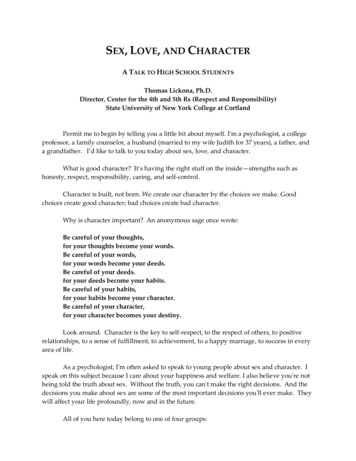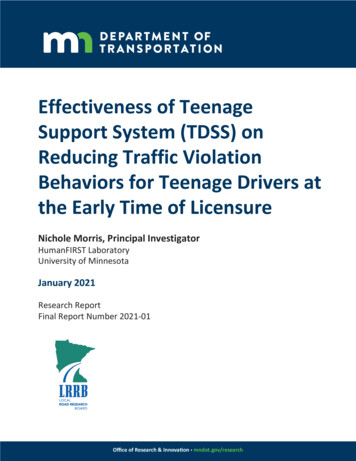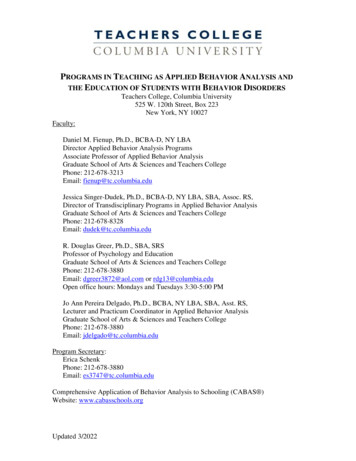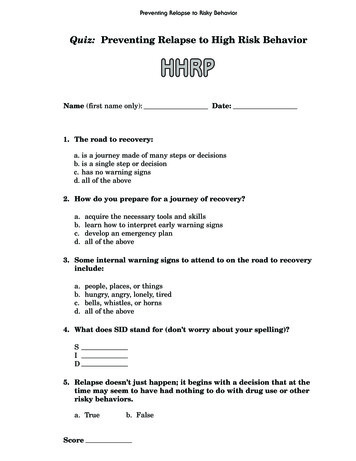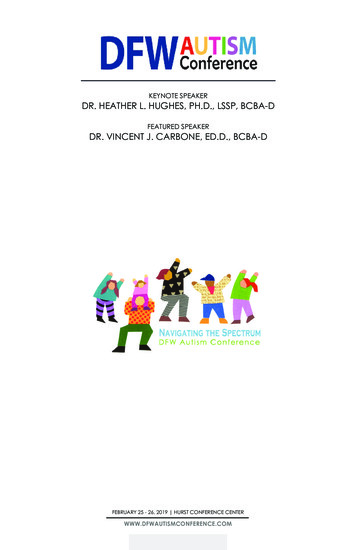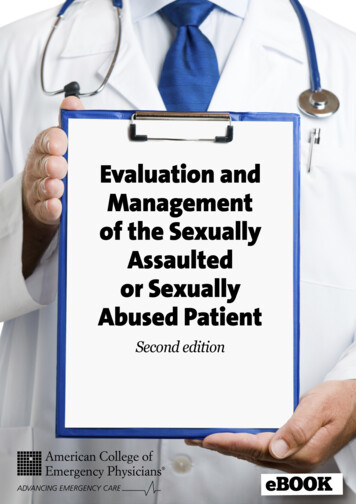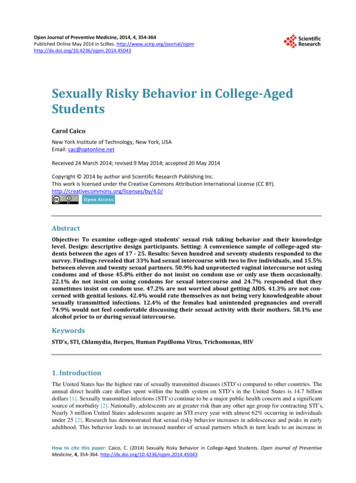
Transcription
Open Journal of Preventive Medicine, 2014, 4, 354-364Published Online May 2014 in SciRes. /10.4236/ojpm.2014.45043Sexually Risky Behavior in College-AgedStudentsCarol CaicoNew York Institute of Technology, New York, USAEmail: cac@optonline.netReceived 24 March 2014; revised 9 May 2014; accepted 20 May 2014Copyright 2014 by author and Scientific Research Publishing Inc.This work is licensed under the Creative Commons Attribution International License (CC tractObjective: To examine college-aged students’ sexual risk taking behavior and their knowledgelevel. Design: descriptive design participants. Setting: A convenience sample of college-aged students between the ages of 17 - 25. Results: Seven hundred and seventy students responded to thesurvey. Findings revealed that 33% had sexual intercourse with two to five individuals, and 15.5%between eleven and twenty sexual partners. 50.9% had unprotected vaginal intercourse not usingcondoms and of those 45.8% either do not insist on condom use or only use them occasionally.22.1% do not insist on using condoms for sexual intercourse and 24.7% responded that theysometimes insist on condom use. 47.2% are not worried about getting AIDS. 41.3% are not concerned with genital lesions. 42.4% would rate themselves as not being very knowledgeable aboutsexually transmitted infections. 12.4% of the females had unintended pregnancies and overall74.9% would not feel comfortable discussing their sexual activity with their mothers. 58.1% usealcohol prior to or during sexual intercourse.KeywordsSTD’s, STI, Chlamydia, Herpes, Human Papilloma Virus, Trichomonas, HIV1. IntroductionThe United States has the highest rate of sexually transmitted diseases (STD’s) compared to other countries. Theannual direct health care dollars spent within the health system on STD’s in the United States is 14.7 billiondollars [1]. Sexually transmitted infections (STI’s) continue to be a major public health concern and a significantsource of morbidity [2]. Nationally, adolescents are at greater risk than any other age group for contracting STI’s,Nearly 3 million United States adolescents acquire an STI every year with almost 62% occurring in individualsunder 25 [2]. Research has demonstrated that sexual risky behavior increases in adolescence and peaks in earlyadulthood. This behavior leads to an increased number of sexual partners which in turn leads to an increase inHow to cite this paper: Caico, C. (2014) Sexually Risky Behavior in College-Aged Students. Open Journal of PreventiveMedicine, 4, 354-364. http://dx.doi.org/10.4236/ojpm.2014.45043
C. CaicoSTI’s [3]. College-aged students are at an extremely high risk of contracting STD risk [4]. College studentsrepresent unique interest to researchers and wellness program directors as well as policy makers interested inpromoting sexual health and wellness in young adults [5]. The CDC (Center for Disease Control) and HealthyPeople 2020 have addressed adolescent STI’s and are targeting gonorrhea and chlamydia with the goal to decreasing these diseases [6].2. Literature ReviewThe most commonly reported STD’s which are an issue for college students in the US are human papilloma virus (HPV), chlamydia, gonorrhea, and genital herpes, trichomoniais and HIV.Human Papilloma Vurus (HPV)—HPV is a virulent virus and is the most common STD in the US affecting20 million young men and women between the ages of 15 - 24. The virus spreads rapidly in adolescents andyoung adults. This is the virus that causes cervical cancer, which is the third most common cause of cancerdeaths among women [7]-[9].Chlamydia—This is the most common reportable bacterial STI in the US. More than 3 million new cases occur annually. It is transmitted though vaginal, anal and oral sex. This is referred to as the silent disease becausein the majority of cases, no symptoms are experienced. Chlamydia is responsible for pelvic inflammatory disease in up to 40% of untreated females [10] [11]. Chlamydia is responsible for infertility in women by scarringthe fallopian tubes. Chlamydia can be treated with antibiotics such as azithromycin or doxycyline.Gonorrhea—Approximately 700,000 new cases are reported annually. This is also contracted through vaginal,oral or anal sex as well as from ejaculation. Symptoms are often mild, and there may be increased vaginal discharge and spotting between periods. This is a serious disease that can also lead to pelvic inflammatory diseaseand inflammation of the uterine tubes leading to scarring resulting in infertility as well as leading to a higher incidence of ectopic pregnancy (pregnancy outside of the uterus) [12]. Gonorrhea can be treated with antibioticssuch as eftriaxone, cefixime, azithromycn or doxycycline. Screening for chlamydia and gonorrhea should beroutine annually. The Center for Disease Control and Prevention (CDC) recommends yearly screening for thoseat risk [13]. There is now evidence of microbial resistance in treating gonorrhea [13].Herpes—Vaginal or penile herpes causes very painful ulcer-like sores and because it is caused by a virus,there is no cure for viruses and recurrent outbreaks of the sores can occur [14]. Genital herpes is a common,transmissible, recurrent, incurable STI. There are antiviral medications which do not cure this STD, but can decrease the viral load which may decrease the frequency of the outbreaks. The majority of new infections occur inadolescents and young adults [15].Trichomoniasis—This STD is caused by a parasite and symptoms are production of a frothy green malodorous discharge. This can be treated and the parasites killed. Both partners should be treated with the appropriateantibiotic usually flagyl.HIV—HIV is still epidemic after 30 yrs since it was first diagnosed. In a survey of young adults aged 19 - 29,it was found that 45% were never tested for HIV and of those 70% gave a reason that they did not believe theywere at risk [16] [17]. It is estimated that 125.104 persons aged 13 and over were newly diagnosed with HIV infection during the years 2006-2009 and a higher percentage were between the ages of 13 - 29 [18]. Young sexually active individuals frequently request an HIV tests because of their engagement in risky sexual behavior.When HIV was first discovered, it was thought to be only a disease affecting homosexual males. It is beingspread by heterosexual intercourse and women are being infected at an alarming rate.HIV screening can identify many HIV cases, and treatment can be started earlier. Homosexual males, bisexuals and substance abusers should be screened often. All pregnant women are routinely screened for the HIVvirus. Although HIV is a virus there are several new combinations of antiviral medications that can effectivelyreduce the virus and add years to the lives of those infected with HIV [19].Young adults frequently make decisions that lead to risky behavior due to inadequate comprehension of STDrisks and their lack the problem solving skills in order to make good decisions [20]. Due to their ineffective negotiation skills and factors such as poor relationship dynamics many do not use condoms nor due women insiston condom use. When condoms are used correctly there is a reduction in the transmissio of STI’s [21]. High risksexual behavior, such as incorrect use of barrier methods and multiple partner selection are common in this agegroup [22]. STI’s are preventable but rates of many STI’s continue to increase particularly among the young. Atrisk individuals may be at risk because of lack of knowledge about STI’s and by not using condoms [23]. The355
C. Caicoproblems with most STI’s is that they can be present with no symptoms, therefore they can be passed on duringsexual intercourse without the partner realizing that they contracted a disease [22]. Nearly 50% of STI’s occur inadolescents and young adults between the ages of 15 and 24. Behavioral factors especially in young women ishaving multiple sexual or new partners and not using condoms [12]. Other factors such as binge-drinking occurin both young men and women and may lead to increased risky sexual behavior and unintended pregnancies dueto decreased inhibitions and moral judgment [24]. Substance abuse and binge-drinking lead to other sexual riskybehaviors including multiple sexual partners. Studies have highlighted that unintended pregnancies result fromdecreases use of condoms and contraceptive use [10].3. SummaryThere are many sexually transmitted infections that can result in life altering consequences to young individuals.A knowledge deficit in the sexually active young population may play a part in the continued risky sexually behavior demonstrated, or possibly just the belief that they are invincible [25].The aim of this research was to examine college-aged student’s risky sexual practices, and identify knowledgegaps regarding particular STD’s and how they are transmitted.4. Method4.1. Design, Setting, and SampleThis study was an exploratory descriptive design. A convenience sample was selected from a population of maleand female students from a private suburban college in the Mid-Atlantic region of the United States. Subjectswere recruited by e-mail invitation sent to the students via a secure anonymous website. Inclusion criteria werestudents who were sexually active and were between the ages of 17 and 25. The population statistics of studentsregistered at the college were 1279 female students and 1948 male students between the ages of 17 and 25. Datacollection was over a 4 month period from mid January to mid May 2012, N 770.4.2. Protection of Human SubjectsThe study was approved by the college’s institutional review board (IRB). Because the study used an on-linedata collection via a monkey survey, total anonymity was maintained. An explanation of the study was providedto the students and participation was completely voluntary. Consent was implied if the students chose to participate, although and informed letter of consent was included with the on-line information. Included was information regarding the researcher contact information. The request to participate assured the students that completeanonymity and confidentiality would be maintained. Participants were then directed to the actual survey. Therewere no link to the student’s e-mails. There was no stipend or any method of coercion for students to participate.Participation was totally voluntary and it was clearly stated only student’s who are or have been sexually activeare to participate.4.3. InstrumentThe survey was designed as a self-administered questionnaire which was converted to a web-based format.There were 46 items on the survey designed to elicit information about student’s sexual history, demographics,sexual practices and knowledge based of many of the sexually transmitted diseases. The demographic questionswere related to gender, age, race, sexual orientation, how many current sexual partners and the school at the college that the student was enrolled in. The items on the survey were an adaptation of questions from three published questionnaires with proven reliability and validity from a book of sexually related measures [9].The questions taken from the three published surveys were used verbatim, and were not altered for this study.Six items on the survey addressed respondents’ history regarding race, age, ethnicity, sexual orientation, numberof current sexual partners and the course of study the student was enrolled in at the college. The instrument contained 6 questions with a range of answers and students were instructed to answer which would apply to them;there were also 15 Likert-type questions with 4 choices; and 19 true and false questions. The questionnaire wasadministered a group of students to determine if the questions were easily understood and all that all questionswere questions answered, which determined content validity and further reliability that the question chosen fromthe three surveys addressed the information for the study.356
C. Caico4.4. ProcedureAn announcement was sent via e-mail to all the students enrolled in the college requesting participation in thestudy. Although the college is global, only the campus located in the Mid-Atlantic coast was included. The announcement described the purpose of the study, including the criteria for voluntary participation and an explanation that the study would include an anonymous survey. The first e-mail included a link directing the students tothe secure website where the survey could be accessed. The e-mail was sent out each week to remind studentsabout the study and requesting their participation. This was done to assure an adequate sample size for the research. Completed surveys were downloaded directly into the survey monkey which the researcher had accessonly to the answers and the number of students who participated.4.5. Demographic FindingsThere were 3229 students at the participating college, 1279 females and 1948 males between the ages of 17 and25. From this population 16% of males and 33.5% of females responded to the study with a total of 770 participants. Although there were no statistics on sexually active students at the college and the assumption is that statistically most college students enrolled are sexually active. A study done at a large northeastern communitycollege evaluating a sexuality course found that over 80% of the students had sexual intercourse [9]. The participants ethnicity and race breakdown was 46.0% Caucasian, 16.3% Asian, 11.4% Hispanic/Latino, 16.8% wereAfrican American. 89.2% were heterosexual, 5.7% were homosexual and 4.3% were bisexual. 81.6% currentlyhave one sexual partner, 8.8% have had two past partners, 4.3% had between three and five partners and 5.2%have had greater than 5 partners. The results by programs at the college were 31.3% were in the School ofHealth Profession, 23.2% were the School of Arts and Sciences, 15.4% were from the School of Engineering,11.3% were from the School of Architecture and 19.0% were from other Programs.4.6. Survey Results33.5% of respondents have had sexual intercourse with between two and five people; 15.5% between six and ten;9.5% between eleven and twenty; and 7.1% over twenty. 37.8% have sexual intercourse less than once a week,31.4% have intercourse between one and two times a week and only 6.1% have intercourse between five andseven times per week. 58.3% responded that their last sexual encounter was less than a week ago and of those,over half had 50.9% had unprotected vaginal sex and 56.8% had unprotected oral sex. 21.1% never insist oncondom use and 24.0% sometimes insists. 47.2% of these sexually active students never worry about gettingAIDS and 27.2 worry about it sometimes. 41.3% do not examine partner for sores, cuts or abrasions in the genital area. 27.8% engage in anal intercourse. 58.1% of this student population drink alcohol prior to or duringsexual intercourse.I insist on condom use when I have sexual intercourse.NeverSometimesMost of the timeAlways357
C. CaicoI worry about getting AIDS1 Never2 Sometimes3 Most of the time4 AlwaysI drink alcoholic beverages prior to or during sexual intercourse1 Never2 Sometimes3 Most of the time4 Always4.7. Survey Results: KnowledgeTo indicate the students’ knowledge about STD’s, a question regarding since sex causes sexually transmitted infections (STI’s) and would they change their sexual practices to avoid contracting STD’s demonstrated that: 51%would not consider abstinence to avoid STI’s. The true and false answers regarding their knowledge of particular STI’s, such as Chlamydia, human papilloma virus (HPV), genital herpes, and HIV were answered with over80% correctly, although 31.9% did not know that untreated chlamydia could caused female infertility. 14.3%answered that they have been treated for an STD. The females had a 12.5% rate of unintended pregnancy. 42%would not rate themselves as being very knowledgeable about sexually transmitted infections, which is a significant amount who admit to a lack of knowledge about STD’s.4.8. Survey Results: Perception62.1% of the study population wonder during sex what the other person thinks of them. 83.3% do feel uncomfortable in sexual situations, yet 74.4% would not share their sexual activity with their mothers.4.9. LimitationsCollecting sensitive data has inherent limitations such as participants not being totally truthful. The true and358
C. Caicofalse questions may have given the participant and easy format for them to answer correctly which was the format for several of the STI questions, yet 42% rated themselves as not being very knowledgeable about STI’s.Just using the total number of students enrolled in the college to determine the percentage of students who participated in the study does not demonstrate an actual percentage as only the students who were sexually activewere requested to participate and there may be many more sexually active students who did not participate eventhough the sample size of 770 participants was good.The research included students from the school of Health Profession who have courses in health topics including learning about implications, and treatment of STD’s. This may have skewed results. Perhaps they shouldhave been excluded from the study. If the students of the Health Professions were excluded, the knowledge deficit regarding STI’s may have been much higher.5. DiscussionThe findings from this study are more comprehensive than other studies done one similar topics. A study doneby Brown [26] looked at alcohol use and partner type as contributing factors in risky sexual behavior and foundunprotected sex was 39% and 32% used alcohol. Compared to the current study which demonstrated an 11.9%higher unprotected sex rate and a 26.2% higher use of alcohol prior to sex. Another comparison is with a studydone on several campuses in California which has a high incidence of no condom use of approximately 48.5%versus the current study had a 2.4% increase. Most studies look only at one or two issues such as contractingeach specific STI’s [27]. Another study done by Jones and Haynes looked at young people’s knowledge ofSTD’s and found similar results in this study in that there is a low knowledge about contracting HIV and a lowconcern of contracting this STD.The study was done in the UK [28] which confirms that young people worldwide take sexual risks. Findingsfrom this study indicate that at one college, there is an increased sexually activity level in the younger population and use of condoms is relatively low, increasing risky sexual behavior.Risk of contracting STI’s does not alter the rate of condom use or the number of sexual partners. A great percentage 74.5% never or sometimes worry about contracting AIDS even with the low condom use. The fact that31.3% of the students were from the School of Health Professions may have accounted for a better understanding of certain sexually transmitted infections. This study indicates that many young adults between the ages of17 and 25 place themselves at unnecessary sexual risks and lack knowledge sexually transmitted infections andthe potential lifelong consequences of many of the STD’s. The results closely correlate to young women whoare being seen in private GYN offices. It is found that adolescents and young women often do not use condomsconsistently. These young patients often request “Can you test me for all STD’s and for an HIV test?” Sexualactivity occurring starting at a younger age and a history of multiple past partners is common. These findingshave very important implications to society. In study of risky adolescent sexual behavior the unintended childbearing was 38% and 19 million STD cases are diagnosed annually. The cost of these unintended births andST’s are very high [29]. There is still a gap in educating the young about the impact of unprotected sex and thepotential lifelong implication of contacting STD’s education must start in all middle schools, be taught again inhigh school and included in college education. It is apparent through the literature search and the results of thisstudy that constant reinforcement of this material is necessary. Nurse Practitioners especially, and all health careproviders who care for adolescent and young adult males and females must direct their efforts to screen for allSTD’s and education during their health visits aimed at increasing knowledge about sexually risky behavior,how STD’s are transmitted and how to protect oneself.Workshops in high school and colleges or in community center where young people congregate would be aperfect opportunity for nurse practitioners and all health care providers and educators across the country to address this epidemic of continued risky sexual behavior. Practitioners should volunteer in their communities toaddress this serious problem. Since nurse practitioners are trusted providers they must continue to reinforce andeducate about the dangers of risky sexual behavior. The older population is facing an increase in sexually transmitted infections as divorce or widowhood places them back in the sexual arena. This is a huge social problemthat needs addressing at all levels. A controlled research study which provided a seminar about sexually transmitted infections, safer sex, decision making. Sexual practices were assessed at baseline and again in 3 monthsto the intervention group of college students. The students who received the education reported increased sexualabstinence in the males but no change in condom uses and the women reported no change in abstinence but an359
C. Caicoincrease in condom use [30].To change the risky sexual behavior education needs to be continually reinforced with seminars held duringthe college years. Education should also be a priority with these adolescent and young adults during their healthexams and when seen in college health departments. Every opportunity to relay the seriousness of sexually riskybehavior and the long term health implications should be implemented.6. Future ResearchSuggested future research should be a correlation study comparing age, ethnicity, sexual preference and withdegree of sexually risky behavior. Students who are enrolled in health related degree programs and may be veryknowledgeable should be eliminated since it may skew the actual results. Other research of interest would be todo a study on the older population and the risky sexual behavior particularly the divorced, widowed or thosewho are sexually active outside of their marriages and compare finding to the same study done on a youngersexually active population.References[1]Chesson, H.W., Gift, T.L., Owusu-Edusel, K., Tao, G., Johnson, A.P. and Kent, C.K. (2011) A Brief Review of the Estimated Economic Burden of Sexually Transmitted Diseases in the United States: Inflation-Adjusted Updates of Previously Published Cost Studies. Sexually Transmitted Diseases, 38, be77[2]Fantasia, H.C., Fontentot, H.B., Sutherland, M. and Harris, A.L. (2011) Sexually Transmitted Infection in Women.Nursing for Women’s Health, 15, 46-57. [3]Yager, A.M. and O’Keefe, C. (2012) Adolescent Use of Social Networking to Gain Sexual Health Information. TheJournal for Nurse Practitioners, 8, 294-298. flieger, J.C., Cook, E.C., Niccolai, L.M. and Connell, C.M. (2013) Racial/Ethnic Differences in Patterns of SexualRisk Behavior and Rates of Sexually Transmitted Infections among Female Young Adults. American Journal of PublicHealth, 103, e1-e7. e, E., Azulay Chertok, A., Winter, V. and Hale, Z. (2013) Sexual Health Behaviors in Random Sample of Students at a Mid-Atlantic University: 2010-2011. Journal of Community Health, 38, 2[6]Center for Disease Control (2010) Healthy People 2020.[7]Carter, J.S. and Downs, L.S. (2011) Cervical Cancer Tests and Treatment. The Female Patient, 36, 34-37.[8]Caico, C. and Driscoll, D. (2009) The Adolescent Pelvic Examination: Challenges, Critical Issues and an Opportunityto Protect Your Patients against HPV. Women’s Healthcare, 8, 20-24.[9]Fisher, D., Davis, C.M., Yarber, W.L and Davis, S.L. (2011) Handbook of Sexuality-Related Measures. 3rd Edition,Sage Publications, Routledge.[10] Friedman, A.L. and Bloodgood, B. (2010) “Something We’d Rather Not Talk about”: Findings from CDC ExploratoryResearch on Sexually Transmitted Disease Communication with Girls and Women. Journal of Women’s Health, 19,1823-1831. http://dx.doi.org/10.1089/jwh.2010.1961[11] Hicky, M. (2009) Female College Student’s Knowledge, Perceptions and Use of Emergency Contraception. JOGNN,38, 399-405. [12] Stamm, C., Miranda, R.H., McGregor, J.A. and Idsog, C.M. (2011) An Evidence-Based Approach to Managing Common STI’s in Adolescents. Contemporary OB-GYN, 43-51.[13] Kieliszek, K. (2011) Trends in Microbial Resistance: Treating Neisseria Gonorrhea Infection. American Journal ofNurse Practitioners, 15, 8-12.[14] Keefe, A. (2012) Managing Genital Herpes and Minimizing the Discomfort. Nurse Prescribing, 10, 326-330.[15] Mansouri, R. and Santos, X.M. (2013) Sexually Transmitted Infections in Adolescents. Contemporary OB/GYN, 58,46-50.[16] Mojola, S.A. and Everett, B. (2012) STD and HIV Risk Factors among U.S. Young Adults: Variations by Gender,Race, Ethnicity and Sexual Orientation. Perspectives on Sexual and Reproductive Health, 44, 125-132.http://dx.doi.org/10.1363/4412512[17] Hoppel, A.M. (2012) HIV: Still Epidemic after 30 yrs. Clinician Reviews, 22, 1,11,13,14,33.[18] Hernandez, A.L., Prejean, J., Doshani, M., et al. (2012) Previous HIV Testing among Adults and Adolescents Newly360
C. CaicoDiagnosed with HIV Infection-National HIV Surveillance System 18 Juristictions, United States, 2006-2009. Morbidity and Mortality Weekly Report, 61, 441-445.[19] Eaton, D.K., Kann, L., Kinchen, S., Shanklin, S., Flint, K.H., Hawkins, L., Harris, W.A., Lowry, R., McManus, T.,Chyen, D., Wjitle, L., Lim. C. and Weschler, H. (2012) Youth Risk Behavior Surveillance United States 2011. MMWR,6, 1-56.[20] Patel, V.L., Yoskowitz, A. and Kaufman, D.R. (2007) Comprehension of Sexual Situations and Its Relationship toRisky Decisions by Young Adults. AIDS Care, 19, 916-922. http://dx.doi.org/10.1080/09540120701203303[21] East, L., Jackson, D., O’Brien, L. and Peters, K. (2010) Condon Negotiation: Experiences of Sexually Active YoungWomen. Journal of Advanced Nursing, 67, 77-85. [22] Samkange-Zeeb, F.N., Spallek, L. and Zeeb, H. (2011) Awareness and Knowledge of Sexually Transmitted Diseases(STD’s) among School-Going Adolescents in Europe: A Systematic Review of Published Literature. BMC PublicHealth, 11, 1-12. http://dx.doi.org/10.1186/1471-2458-11-727[23] Picot, J., Shepherd, J., Kavanagh, J., Cooper, K., Harden, A., Barnett-Page, E., Jones, J., Clegg, A., Hartwell, D. andFrampton, G.K. (2012) Behavioural Interventions for the Prevention of Sexually Transmitted Infections in YoungPeople Aged 13-19 Years: A Systematic Review. Health Education Research, 27, 495-512.http://dx.doi.org/10.1093/her/cys014[24] Weeder, S.K. (2011) Binge Drinking and Disordered Eating in College Students. Journal of the Academy of NursePractitioners, 23, 33-41. [25] Scott, M.E., Wildsmith, E., Welti, K., Ryan, S., Schelar, E. and Steward-Streng, N.R. (2011) Risky Adolescent SexualBehavior and Reproductive Health in Young Adulthood. Perspectives on Sexual and Reproductive Health, 43, 110-118.http://dx.doi.org/10.1363/4311011[26] Brown, J. (2007) Alcohol Use, Partner Type, and Risky Sexual Behavior among College Students: Findings from anEvent-Level Study. Addictive Behaviors, 32, 2940-2952. http://dx.doi.org/10.1016/j.addbeh.2007.06.011[27] Trieu, S.L., Bratton, S. and Marshak, H.H. (2011) Sexual and Reproductive Health Behaviors of California CommunityCollege Students. Journal of American College Health, 59, 744-750. http://dx.doi.org/10.1080/07448481.2010.540764[28] Jones, N.A. and Haynes, R. (2006) The Association between Young People’s Knowledge of Sexually Transmitted Diseases and Their Behavior: A Mixed Methods Study. Health Risk and Society, 8, 1[29] Fontenot, H. and Morelock, N. (2012) HPV in Men Is a Women’s Health Issue. Nursing for Women’s Health, 15,57-66. [30] Turner, J.C., Korpita, E., Mohn, L. and Hill, W.B. (1993) Reduction in Sexual Risk Behaviors among College StudentsFollowing a Comprehensive Health Intervention. Journal of American College Health, 41, 36324361
C. CaicoQuestionnaire Used in StudyYour Personal Characteristics1. What is your gender?O MaleO Female2. How old are you3. Which racial/ethnic category best describes you?O African AmericanO CaucasianO Asian AmericanO Hispanic/Latino/LatinaO Native AmericanO OtherPlease specify4. Which sexual orientation category best describes you?O HeterosexualO HomosexualO BisexualO OtherPlease specify5. How many sexual partners do you currently have?Sexual Behavior QuestionnairePlease indicate the following questions with the letter that best fits your answer.1. How many individuals have you had sexual intercourse with?a. Noneb. Only onec. Between two and fived. Between six and tene. Between eleven and twentyf. Over twenty2. How many times a week do you engage in sexual intercourse?a. Less than oneb. Between one and twoc. Between three and fourd. Between five and sevene. More than seven3. When you engage in sexual interco
STD's, STI, Chlamydia, Herpes, Human Papilloma Virus, Trichomonas, HIV 1. Introduction The United States has the highest rate of sexually transmitted diseases (STD's) compared to other countries. The annual direct health care dollars spent within the health system on STD's in the United States is 14.7 billion dollars [1].

